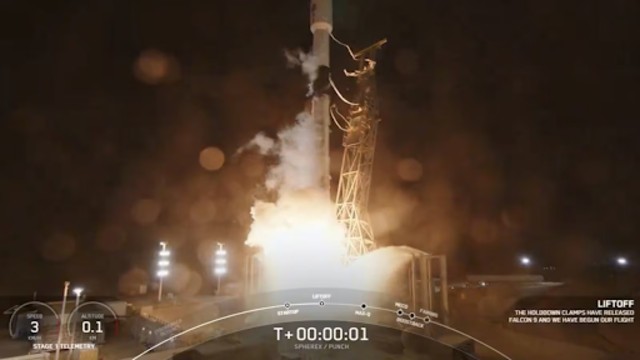
A SpaceX Falcon rocket carrying NASA’s new space telescope, Spherex, blasts off from Vandenberg Space Force Base in California on Tuesday, March 11, 2025. This image, taken from a video provided by SpaceX, captures the moment of liftoff. AP Photo
NASA’s latest space telescope took off on Tuesday, aiming to create a detailed map of the sky. This new mission will study hundreds of millions of galaxies and their combined glow from the universe’s early days.
A SpaceX rocket launched the Spherex observatory from California, sending it into orbit over Earth’s poles. Alongside Spherex, four small satellites joined the mission to study the sun. As the rocket’s upper stage released Spherex, it drifted into space with Earth’s blue glow in the background.
The $488 million Spherex mission hopes to explain how galaxies formed and changed over billions of years. It will also study the rapid expansion of the universe during its early moments. Closer to home, Spherex will search for water and other key life-building elements in the icy clouds between stars, where new solar systems form.
Spherex, about the size of a grand piano and weighing 1,110 pounds (500 kilograms), will spend six months scanning the entire sky with its infrared sensors. The telescope will complete four full-sky surveys over two years while orbiting Earth at 400 miles (650 kilometers) above the surface.
Unlike NASA’s Hubble and Webb telescopes, which focus on capturing detailed images of galaxies, Spherex will take a different approach. Instead of looking at individual galaxies, it will measure the total glow produced by all of them, including the very first galaxies that formed after the Big Bang.
“This cosmological glow captures all light emitted over cosmic history,” said Jamie Bock, the mission’s chief scientist at the California Institute of Technology. “It’s a very different way of looking at the universe,” he added, explaining that this method may reveal sources of light that scientists have missed before.
By analyzing this glow, researchers hope to uncover information about the first galaxies and how they developed. Bock explained that while the telescope won’t see the Big Bang itself, it will observe its aftermath and provide insights into the universe’s origins.
Spherex’s advanced infrared sensors can detect 102 colors that are invisible to the human eye. This will allow scientists to create the most detailed and colorful cosmic map ever made. “It’s like looking at the universe through a set of rainbow-colored glasses,” said Beth Fabinsky, deputy project manager at NASA’s Jet Propulsion Laboratory.
To keep its detectors at the extreme cold needed for infrared observations—minus 350 degrees Fahrenheit (minus 210 degrees Celsius)—Spherex has a unique design. It features three aluminum-honeycomb cones nested inside one another, forming a protective barrier against heat from the sun and Earth. This design gives the telescope a distinct appearance, resembling a large shield collar.
In addition to Spherex, the launch also carried NASA’s Punch mission. This group of four small satellites will observe the sun’s outer atmosphere and the solar wind from their own orbit.
The launch, originally scheduled two weeks earlier, faced delays due to technical issues. However, with the telescope now in space, NASA is ready to begin its groundbreaking mission to unlock the secrets of the universe.















